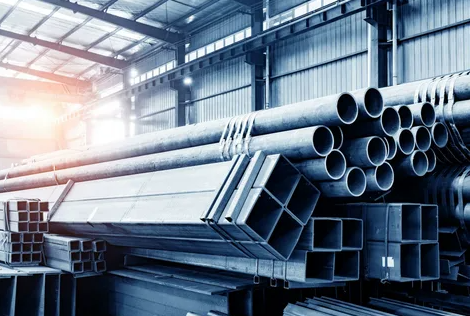According to Beijing-based commodity consultant Simon Wu, steel mill owners in parts of China are in a bad mood.
Steel inventories are slowly building up in warehouses at the country's largest steel center, the northeastern city of Tangshan, as well as in the provinces of Jiangsu and Shandong, said Wu, senior consultant at Wood Mackenzie, the mill's owners.
According to them, the demand for steel is falling amid quarantine due to the pandemic and a decrease in construction activity.
“Negative energy is everywhere. The steel industry is simply not making any profit,” Wu said.
A lot of steel - a key raw material in the manufacturing hub - sits idle across the country as the economy shuts down and restarts, driving down demand and prices.
Prices for both steel and iron ore, its main ingredient, were volatile during the Shanghai lockdown, but they went down earlier this month.
Weak demand for steel, a major driver of China's economy, also reflected a broader slowdown in the country's economy, although recent data point to some improvement as industrial production rose 0.7% year-over-year in May.
Importantly, China's steel industry - the world's largest - has extensive supply chains that stretch from Chinese blast furnaces to overseas iron ore mines in Australia and Brazil, China's largest iron ore suppliers.
Because of this, any unrest within China could disrupt an extensive network of supply chains, potentially adding pressure to existing global disruptions.
According to the China Iron and Steel Industry Association, daily production of intermediate steel products such as crude steel and pig iron, as well as finished goods, rose by about 1-3% in May. On the contrary, demand, although it remained active, fell.
For example, crude steel consumption in China fell 14% in May from a year ago, Nicky Wang, lead iron ore specialist at S&P Global Commodity Insights, said, citing his own analysis.
“The annual decline in steel demand was much larger than the decline in crude steel production. In this case, the steel mills are really fighting [pressure on steel prices],” she said.
This period coincided with China's largest citywide pandemic in Shanghai.
Consequently, inventory levels are 12% higher year-over-year and could take almost two months to fall to the average of the last five years, assuming steel demand comes back to life, said Richard Lu, steel research analyst at CRU Group.
The Chinese market is also competing with cheaper Russian semi-finished steel products, said Paul Lim, lead Asian black commodities and steel analyst at Fastmarkets Asia.
As epidemics swept across the country, the country's largest consumers of steel, as well as growth engines for the Chinese economy, such as real estate construction and infrastructure development, fell silent, according to Atilla Widnell, managing director of Navigate Commodities.
That's because "there is simply no one to work at the facilities," he added, noting that the industry has been overwhelmed by the return of lockdowns.
After the long-awaited reopening of Shanghai in early June after new cases were reported in both Beijing and Shanghai, China has begun to reintroduce some of the restrictions.
Last week, new data from China's National Bureau of Statistics showed that real estate investment in the first five months of the year fell 4% from the previous year, up from a 2.7% fall between January and April.
Home sales by volume fell 34.5% year on year in the first five months of 2022.
“There were signs of life for domestic steel consumption after China emerged from lockdown in early June, but the disruptions caused by the recurrence of disparate lockdowns were an unwelcome blow to the country's well-intentioned economic recovery. "Widnell said.
You Can't Just Shut Down Blast Furnaces
Even though steel prices fell and reduced the profitability of steel production, steel mill owners continued to produce, with many using lower quality iron ore to produce smaller volumes.
China's blast furnaces are now running near full capacity, more than 90% - the highest in 13 months - despite declining profits, analysts said.
Lu said some factories suffered "largely negative margins" in April and May.
Price data show that prices for popular steel products such as rebar and hot-rolled coil used to build homes have fallen by almost 30% since peaking in May last year following an industrial recovery that boosted the economy.
Shutdown of blast furnaces may be inefficient,
Subscribe to news 
Metallurgy news
- Today
02:00 Scrap metal exports from the United States grew by 10.5 percent in August 2025. 02:00 Steel Dynamics acquires remaining 55 percent of New Process Steel shares - 03 December 2025
18:00 The strategy for the development of the Russian coal industry should take into account the future reduction of coal consumption in India 17:00 Japanese car production fell slightly in September 2025 17:00 Domestic sales prices of Turkish metallurgists in November 2025 increased by 1.63% compared to October 16:00 CISA calls on Chinese iron ore producers to speed up key local projects 16:00 Japan's JFE Steel invests $1.75 billion in joint venture with JSW Steel to manage BPSL plant 15:00 The first shipment of iron ore from Simandhu went to China
Publications
03.12 Sports news and analytics: how interest in sports is generated in the world 03.12 Fitness Sofia: space for health and strength 29.11 Quests for large companies: how to organize a perfect day off 28.11 Entdecke die Unterwasserschätze von Marsa Alam 27.11 Upholstered furniture reupholstery services from Aego






